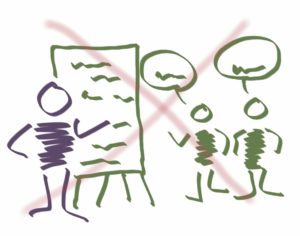We’ve been discussing the concepts of ideation and the workshop activities that we do to generate ideas. These activities use the intent behind ‘brainstorming’ – not that I am recommending the common form, let me explain why.
The method that springs to mind when we mention ‘brainstorming’ is for a facilitator to capture ideas onto a whiteboard while people call them out. There are many issues with using the method in this way related to good old human nature such as our tendencies to focus on the first theme mentioned or our tendency to defer to people in positions of perceived higher status.
 There are many better ways to generate ideas from design thinking and other facilitation approaches such as
There are many better ways to generate ideas from design thinking and other facilitation approaches such as
- Silent brainstorming
- Rapid sketching
- Surfacing assumptions and generating hypotheses
What if we are working on a big, important goal? There are many questions that we overlook because it’s easy to make the assumption that once was enough and doing a process of discovery again might generate more work than we desire.
- Should we facilitate only one of these idea-generation sessions with one group of people?
- How can we know if we have looked at the goal from enough angles?
- If we should do it more than once, then how many times and how much time between the sessions?
Perhaps this is the original intent behind governance processes. We know that humans are very creative and are likely to learn much at the beginning of a piece of work that leads to more interesting ideas as we proceed. In an idealistic world, the process of governance is a way of checking in with a bunch of smart people to help us identify key decisions and make those decisions in a timely manner.
Those same smart people can also assist with identification of the needs to re-discover – perhaps they have learned something useful from elsewhere that could help us to reach our goal sooner or obtain better outcomes. This new information might be a reason to facilitate another ideation session – but how many of us would want to set that up? It seems much easier to take the new information and simply work it into our current set of tasks.
How can you tell and why should you revisit old ground?
Things change, information is not static and the believed facts can also change with time as a better understanding is developed.
So if we acknowledge this reality then the attitude that we should only plan, then act, denies the fact of change. Imagine a set and forget toy on a table, the inevitable outcome is that it will eventually fall off. This is the very reason why biology, engineering, mechanics and programming are full of feed back loops and reiterations, so monitoring and corrections can be made. It is naive to think our projects are somehow exempt from change.
The size, complexity, number of inter-dependencies all increase the requirements for re-discovery, so we should always be asking ourselves if it makes sense to continue, or to pause and do some form of re-discovery at regular intervals.

